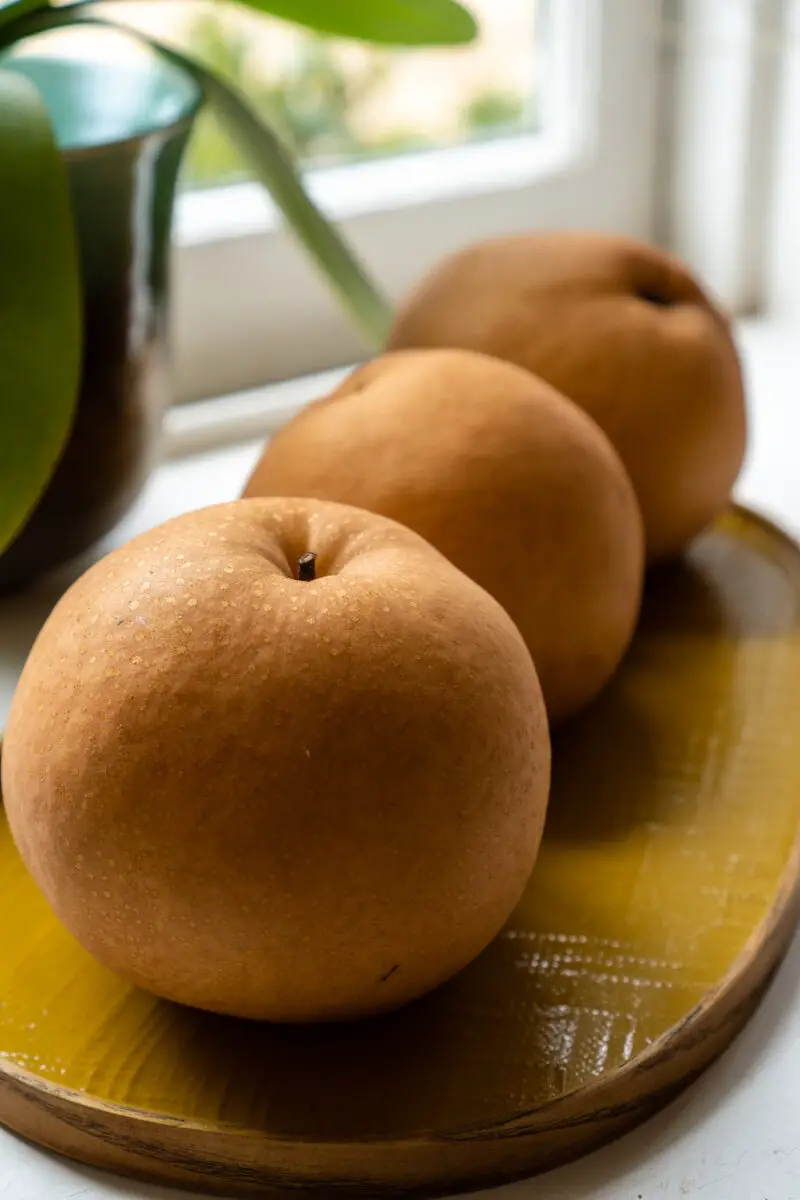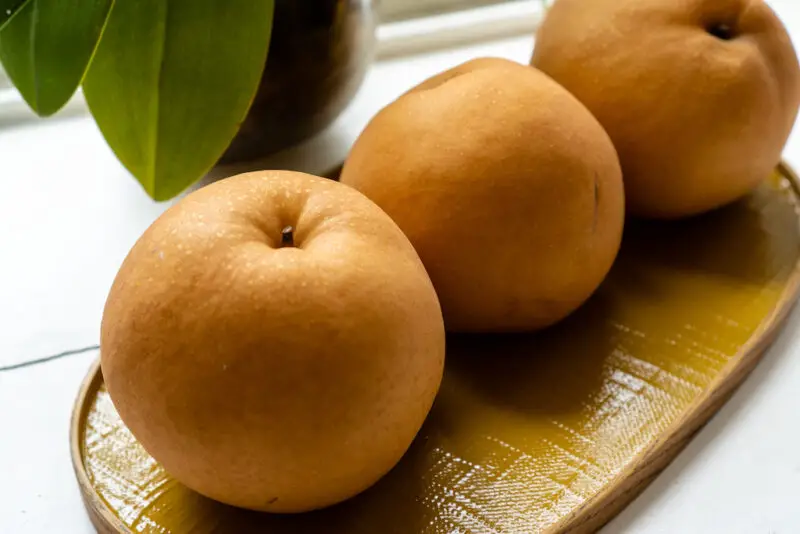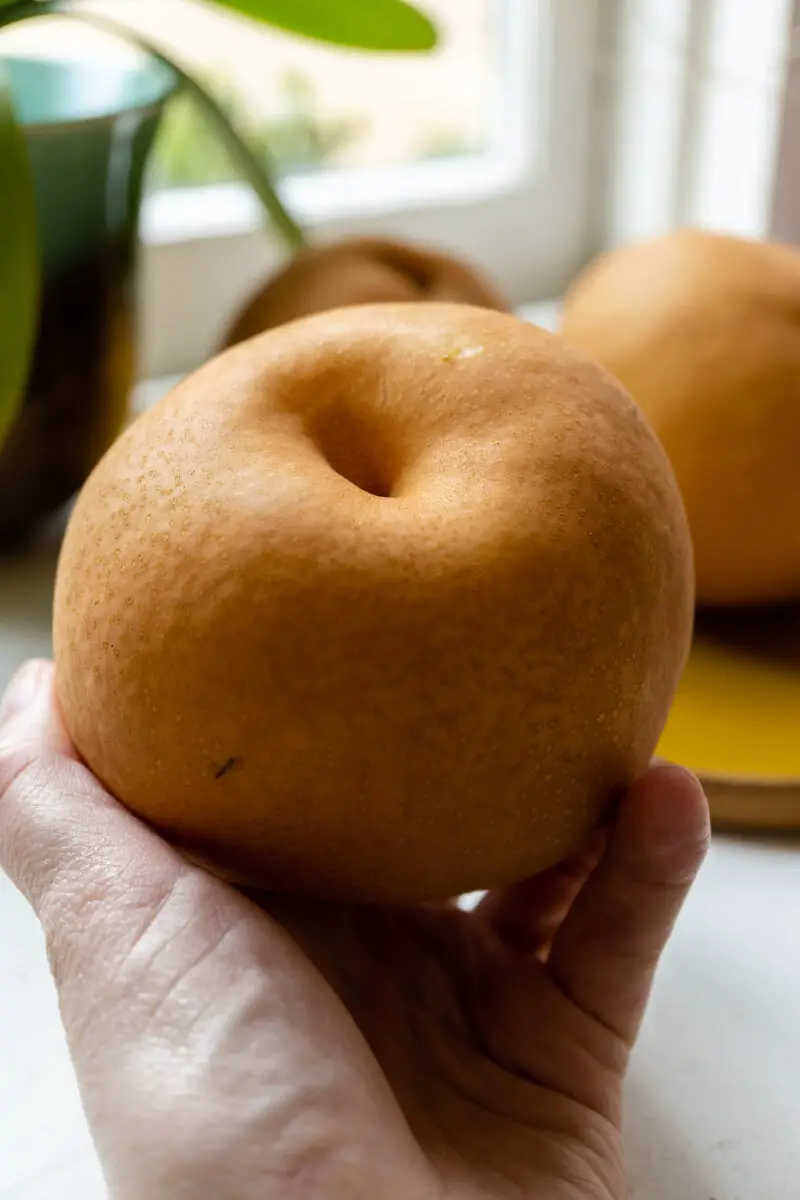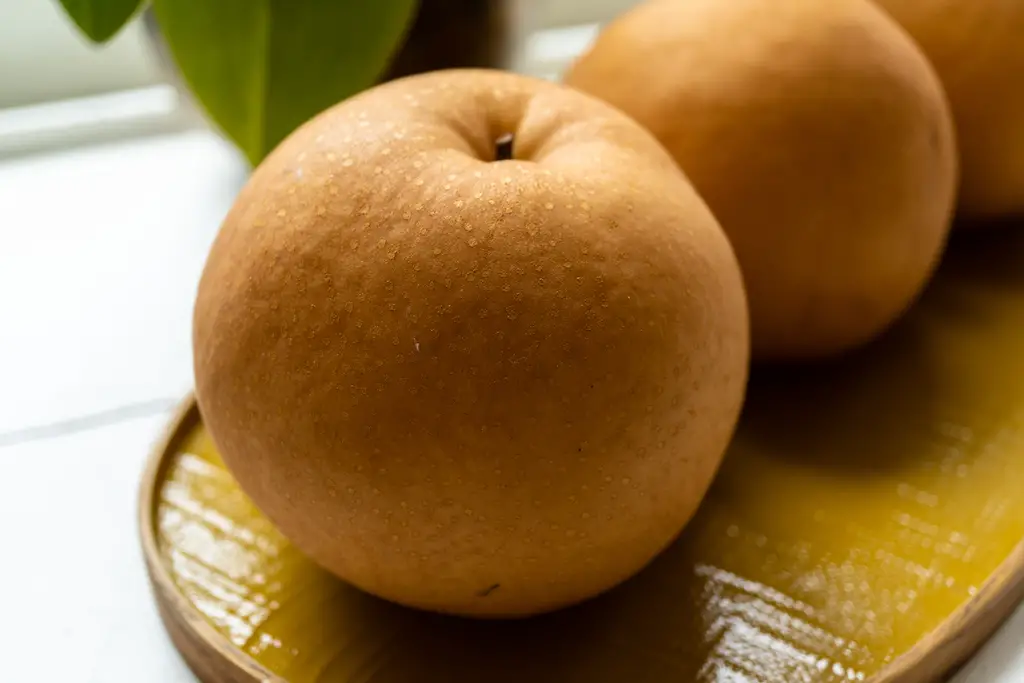This post may contain affiliate links. Please read my disclosure for details at the bottom of this page. As an Amazon Associate, I earn from qualifying purchases on this post about the Asian pear. Here, learn all about the Asian pear (Korean pear) and how people use this ingredient in South Korea!
Published 10/05/2021 Updated 02/01/2023
The Asian pear, known scientifically as the Pyrus pyrifolia, is a species of pear native to certain areas of East Asia. This pear, also known as the Japanese pear, Chinese pear, Korean pear, Taiwanese pear, apple pear, sand pear, and more, is an integral part of many East Asian cuisines and food cultures.
Previously, I listed the Asian pear in my post about the most commonly eaten fruits in South Korea. In this post, I will list some informative Korean culture facts as well as some foods which use the Asian pear as an ingredient. Then, I will cover some frequently asked questions you may have about this ingredient.

Asian Pears in Korean Culture:
In the Korean language, these fruits are known as ‘bae’ (배). Below, I list some interesting facts about this ingredient in Korean culture:
- In Naju, South Korea, you can visit a museum called The Naju Pear Museum and Pear Orchard for Tourists (나주 배 박물관 및 배밭 관광체험). The city of Naju, as well as the communities surrounding the city, produce much of the Asian pears available to eat in South Korea.
- Growing these pears can often be labor-intensive. As a result, these fruits can be extremely expensive. People often give these pears as gifts or serve them to guests in their homes.
- Further, people often use these pears as ceremonial food in South Korea. As Korea became more and more influenced by Confucianism during the Joseon Dynasty, people began preparing food for certain ceremonial practices. One of these practices includes Ancestral rites known as ‘jerye’ (제례). During these rites, people prepare a table of food for their ancestors who passed. Each row of food on the table holds foods associated with certain flavors and meanings. On the 5th row, people place fruits and sweets. Often, this includes the Asian pear which sits on the western side of the table.
- Like the cherry blossom, the pear tree flowers also symbolize the early spring season. People often travel to see the beautiful pear tree fields.
Do you know of some other interesting Asian pear facts? If so, let me know!

Korean Foods Using the Asian Pear:
In South Korea, people commonly use Asian pears to make popular dishes. Below, I list some of the most common ways people use it as a cooking ingredient in Korean cuisine.
Examples of Asian Pear in Korean Cuisine:
- Bulgogi (불고기): In Korean ‘bulgogi’ refers to a type of thinly sliced or minced beef or pork that is marinated before being grilled or stir-fried on a barbecue/griddle. The Korean pear is used as a sweetener and tenderizer for this dish–The Asian pear contains particular types of enzymes that tenderize the proteins in meat.
- Baesuk (배숙): Baesuk is a traditional Korean pear dessert made by either poaching or steaming pears. You then place these pears in a fruit punch liquid made of ginger, honey, sugar, black peppercorns, and water.
- Bibim-Naengmyeon (비빔냉면): Bibim-naengmyeon is a type of cold Korean noodle served during the summer and early fall. Often, people place sliced or shaved Korean pears onto the noodles. The pears add crunchiness as well as sweetness to the dish.
Frequently Asked Questions About Asian Pears:
Below, we answer some questions you may have about Asian pears. If we did not answer your question, feel free to leave your question in the comment section below or email us at [email protected].
How to Tell if Asian Pears are Ripe?
When choosing an Asian pear, you need to look at a few different factors. Unlike other types of pears, the Asian pear is still firm when ripe. So, I list some things to help you find the perfect ripe Asian pear below. I hope this helps!
- First, check its color: There are two types of Asian pears to consider. On one hand, for Asian pear varieties from Japan, the skin changes to a yellowish-brown color when ripe. On the other hand, for pears coming from the Chinese variety, the skin changes to a greenish-yellow when ripe. Always check the entire pear–the color should be evenly distributed instead of appearing in spots.
- Check the thickness of the skin: Fully ripe Asian pears have thinner skin than their unripe counterparts.
- Next, check the smell: When ripe, these pears should smell strongly sweet. If you cannot smell the fruit when you hold it up to your nose, then it is not ripe.
- Finally, if you can, taste the pear: These pears should have a crispy and juicy texture with a sweet taste. If the pear is mushy instead of crispy, it is overripe. Often, people compare the texture more to an apple than other varieties of pears.
Avoid pears with wrinkled, bruised, or dark skin. These pears are already overripe and will not taste as delicious!

Where to Buy a Korean Pear?
While you can buy different varieties of pears throughout the year, these typically only appear in grocery stores when in season during the fall and winter months. You can find these Korean pears starting mid-autumn in well-stocked grocery stores such as Whole Foods and Wegmans.
While you can often find these pears at your typical grocery store, it is not always guaranteed. Instead, try shopping at your local Asian market. Usually, they will all carry these pears during the cooler months as well.
How Do I Store an Asian Pear?
To keep Asian pears from rotting, keep them in a cool and dry place. At room temperature, fully ripe Asian pears can stay fresh for a week. In a refrigerator, they can keep for up to three months!
I Hope You Enjoyed Learning About the Korean Pear!
In the end, I hope you enjoyed learning about ‘bae,’ otherwise known as an Asian pear or Korean pear. If so, let us know in the comment section below. Also, what do you usually make if you cook with these fruits?
If you would like to read more about cooking, you can find recipes on my blog. Below, I listed some of my favorite Carving A Journey Korean recipes below! For reference, many recipes are influenced by our blended Korean and Southern heritage.
Korean Ingredient Articles:
Further Carving A Journey Korean Recipes:
- Greek Momo Recipe (Korean Breakfast Trend)
- Tteokkochi (Korean Rice Cake Skewers)
- Jumeokbap (Handmade Korean Rice Balls)
If you have any questions or comments, you can also email me at [email protected].
And, finally, I would love to hear from you through our social media as well! You can follow me at @carvingajourney on Instagram, Twitter, Facebook, and Pinterest. Or, if you would like more articles like these, you can subscribe to our blog by joining my mailing list. I hope you enjoyed learning about Asian pears! Soon, I will be publishing more recipes using this Korean ingredient! Thank you so much for stopping by!
Carving A Journey is a participant in the Amazon Services LLC Associates Program, an affiliate advertising program designed to provide a means for sites to earn advertising fees by advertising and linking to Amazon.com. Although we may earn commissions for our endorsement, recommendation, testimonial, and/or link to any products or services from this website, these opinions are my own and I fully support these products.

